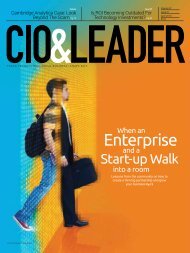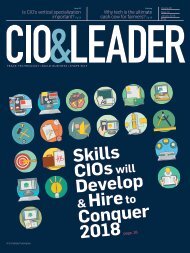CIO & LEADER-November 2017 (1)
You also want an ePaper? Increase the reach of your titles
YUMPU automatically turns print PDFs into web optimized ePapers that Google loves.
Insight<br />
1. SDN has lift off!<br />
With software-defined networking<br />
(SDN) deployments now live around<br />
the globe, companies are beginning to<br />
explore what they can really do with<br />
the security, agility and flexibility of<br />
virtualized network services. The next<br />
big thing is application-aware networking<br />
– managing the performance,<br />
capabilities and security of applications<br />
to make the most of bandwidth<br />
- ever more critical in an increasingly<br />
complex content world.<br />
2. Security goes<br />
underground<br />
Security will undertake a step change<br />
in 2018, and become embedded into<br />
the platform, supporting everything<br />
a business does. We’re talking end-toend<br />
managed security infrastructure<br />
for the network, the developer and<br />
applications. In today’s threat landscape,<br />
it’s all about global scale – but<br />
openness and information sharing to<br />
combat the bad guy, both online and<br />
in the real world will also become the<br />
norm. With this step change, measuring<br />
security effectiveness is imperative<br />
so that cyber-risks can be integrated<br />
into any enterprise risk assessment.<br />
The quantification of security posture,<br />
maturity and hygiene will not only<br />
enable effective risk management, but<br />
also establish a security ROI - a key<br />
ability for the C-suite.<br />
3. Digital collaboration is<br />
table stakes<br />
Savvy organizations have been moving<br />
away from aging PBXs to IP-based<br />
telephony systems over recent years<br />
- but 2018 will be the year when digital<br />
technologies really begin to transform<br />
workplace collaboration, not least as<br />
third party compliance becomes a<br />
major frustration. Employees expect to<br />
be able to seamlessly access calendar<br />
information, share documents and<br />
schedule calls across platforms, quickly<br />
and securely. The focus is therefore<br />
on enabling multi-channel access to<br />
improve both the user experience and<br />
productivity. Software-defined networking<br />
will facilitate intelligent data<br />
management and multi-platform call<br />
routing for more effective collaboration,<br />
and mobile apps will put the<br />
power of information directly into the<br />
hands of employees or consumers.<br />
4. Artificial Intelligence<br />
and Robotics take on the<br />
Internet of Things<br />
IoT will become part of the fabric of an<br />
organization in 2018 – the challenge<br />
will be how to integrate device management<br />
into overall IT infrastructure<br />
in a way that doesn’t overwhelm the<br />
organization. This is where AI and<br />
robotics will come into their own,<br />
offering intelligent automation of<br />
managed IoT deployments cheaply<br />
and efficiently.<br />
5. People take control of<br />
the digital experience<br />
Consumers are increasingly aware of<br />
the power of their data, and in 2018<br />
will become choosier about their<br />
engagements. Brands will need to be<br />
aware of how they deal with data, as<br />
their customers will be looking for<br />
mobile, secure, simple interactions for<br />
a higher level of intimacy. Brands that<br />
can deliver on this will stand out.<br />
6. Interoperability will<br />
be a priority for public<br />
safety<br />
<strong>2017</strong> has seen a large number of both<br />
terrorist incidents and natural disasters<br />
around the globe. Seamless, secure<br />
connections across rapidly deployable<br />
networks -- particularly those dedicated<br />
to first responders – will be a critical<br />
focus in 2018, particularly in the<br />
United States in the context of FirstNet.<br />
Interoperability will let companies<br />
and public safety organizations benefit<br />
from choice in network and technology<br />
services, will drive innovation through<br />
market competition, and will also<br />
help control costs. Most importantly,<br />
interoperability will better enable first<br />
responders to keep in touch and communicate<br />
with authorities and private<br />
citizens, should disaster strike.<br />
7. Simple is the goal<br />
As the world becomes more complicated,<br />
business success is increasingly<br />
about separating out core versus chore.<br />
Successful organizations will focus<br />
on delivering key business outcomes,<br />
and will outsource the non-core to key<br />
partners. Working out who does what<br />
to quickly reduce complexity to the<br />
point where things become simple will<br />
define future business success<br />
<strong>November</strong> <strong>2017</strong> | <strong>CIO</strong>&<strong>LEADER</strong><br />
15














